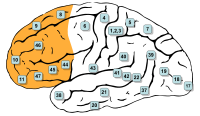
Photo from wikipedia
HighlightsIt is unknown whether prefrontal (PFC)‐perirhinal cortical (PER) connectivity is necessary for flexible behavior.Rats were tested on a biconditional object‐place paired association test of flexibility.Disconnection of the PFC and PER… Click to show full abstract
HighlightsIt is unknown whether prefrontal (PFC)‐perirhinal cortical (PER) connectivity is necessary for flexible behavior.Rats were tested on a biconditional object‐place paired association test of flexibility.Disconnection of the PFC and PER significantly disrupted performance.Disconnected rats regressed to a perseverative response of selecting objects on one side.These findings are consistent with a critical role for PFC‐PER circuits in updating a response rule across spatial locations. ABSTRACT The ability to use information from the physical world to update behavioral strategies is critical for survival across species. The prefrontal cortex (PFC) supports behavioral flexibility; however, exactly how this brain structure interacts with sensory association cortical areas to facilitate the adaptation of response selection remains unknown. Given the role of the perirhinal cortex (PER) in higher‐order perception and associative memory, the current study evaluated whether PFC‐PER circuits are critical for the ability to perform biconditional object discriminations when the rule for selecting the rewarded object shifted depending on the animal’s spatial location in a 2‐arm maze. Following acquisition to criterion performance on an object‐place paired association task, pharmacological blockade of communication between the PFC and PER significantly disrupted performance. Specifically, the PFC‐PER disconnection caused rats to regress to a response bias of selecting an object on a particular side regardless of its identity. Importantly, the PFC‐PER disconnection did not interfere with the capacity to perform object‐only or location‐only discriminations, which do not require the animal to update a response rule across trials. These findings are consistent with a critical role for PFC‐PER circuits in rule shifting and the effective updating of a response rule across spatial locations.
Journal Title: Neurobiology of Learning and Memory
Year Published: 2017
Link to full text (if available)
Share on Social Media: Sign Up to like & get
recommendations!